With their breezy fronds, potted palm plants bring a tropical feel to indoor spaces. There are many types of palm plants, but they all feature fan or feather-shaped leaves on a long stem. Most can grow as well indoors as out. Potted palms are relatively easy care houseplants. All they need is moderate water, light and temperature. Read on to learn about which ones will work best for you.
Areca palms and majesty palms are two of the most popular choices for indoor palm trees. With their tropical look and easy care requirements, it’s no wonder why they are so common in homes and offices.
But if you’re trying to decide between areca vs majesty, it can be tough to pick one over the other. While similar in some ways, there are a few key differences that set these palms apart
In this article, we will compare and contrast areca palms and majesty palms to help you determine which is best for your space We’ll look at factors like
- Size
- Appearance
- Care needs
- Light requirements
- Price
- And more!
An Overview of Areca Palms
The areca palm (Dypsis lutescens) is also known as the butterfly palm golden cane palm, or yellow palm. Native to Madagascar this palm gets its name from the seed, which is often chewed as an intoxicant.
Some key facts about areca palms:
- Grows up to 20 feet tall indoors, but can reach 30 feet outside.
- Slender trunk is topped with graceful, arching fronds.
- Fronds are pinnate (feather-shaped) and grow in clusters.
- Thrives in bright indirect light or partial sun.
- Tolerates a range of humidity levels.
- Relatively fast growing.
Areca palms have a feathery, delicate appearance that makes them perfectly suited for smaller spaces. Their wispy, arching fronds also give them an airy, tropical vibe.
An Overview of Majesty Palms
Majesty palms (Ravenea rivularis) hail from Madagascar. They get their regal name from the dignified crown formed by their leaves.
Some key facts about majesty palms:
- Grows 10-20 feet indoors, up to 70 feet in ideal conditions.
- Single grayish trunk ringed with leaf scars.
- Large, feathery fronds arranged in a crown.
- Prefers bright light, even full sun.
- Likes consistent moisture and humidity.
- Slow growing compared to areca.
With their grand, fanning leaves, majesty palms live up to their noble name. Their large size and traditional palm structure makes them a bold accent plant.
Now that we’ve covered the basics, let’s compare these two palms head-to-head.
Areca vs Majesty: Size
When it comes to size, majesty palms tend to be larger than areca palms. Indoors, areca palms generally grow to about 6-12 feet tall at maturity. Meanwhile, majesty palms can reach impressive heights of 10-20 feet inside.
So if you’re looking for a smaller palm, the areca is a better choice. But majesty palms make a big, dramatic statement thanks to their substantial size.
Appearance: Fronds and Trunks
These two palms have distinctly different looks when it comes to their fronds and trunks.
Areca palms have graceful, feathery fronds that arch out from the top of slender, smooth trunks. The fronds grow in clusters, giving the palm a full, bushy appearance.
Majesty palms have a more formal, dignified look. A single trunk is topped with wide fronds arranged in a crown shape. The large fronds fan out dramatically from the tip of the trunk.
So areca palms have a softer, wispier look, while majesty palms are bolder with their grand, fanning fronds.
Care Needs and Growth Rate
When it comes to care and growth habits, areca palms tend to be easier going and faster growing than majesty palms.
Areca palms adapt well to a range of light, humidity, and temperature conditions. They also grow quickly, averaging 2-4 feet per year when conditions are right. This makes them a good choice if you want your palm to fill in faster.
Majesty palms grow at a much slower pace, averaging only 1-2 feet per year. They also require more specific care, disliking extremes in humidity and temperature. Consistent moisture is important for majesty palms.
So areca palms are better for beginning palm growers, while majesty palms require a bit more experience and attention.
Light Requirements
Light is another key difference between these species. Areca palms do best in medium to bright indirect light. They can adapt to lower light, but their growth will slow.
Majesty palms need abundant light to look their best. They prefer very bright locations, even tolerating some direct sun. With insufficient light, the fronds will become sparse and stunted.
So if you have a shady spot, an areca is a safer bet. But majesty palms are a great choice if you have a sunny room with tall windows or skylights.
##Humidity Preferences
Humid conditions are appreciated by both types, but majesty palms are pickier when it comes to sufficient moisture.
Areca palms tolerate a wide humidity range, from 30% to over 80% relative humidity. Ideal levels are 50-70%.
Meanwhile, majesty palms want consistently damp air above 50% humidity at all times. Mist the fronds frequently and use a humidifier during dry winter months.
Price Comparison
As you may have guessed based on size and growth rate comparisons, majesty palms typically cost more than areca palms of equivalent heights.
For a 6-8 foot areca palm, expect to pay $60-130. Majesty palms of the same size range from $100-250. Larger specimens 10 feet and up can cost $250 or more.
So if budget is a concern, areca palms give you more plant for your dollar in most cases. But majesty palms make a bolder impression if you have the space and budget to accommodate them.
Ideal Environment for Each
Here’s a quick overview of the ideal growing conditions for each species:
Areca palms:
- Bright indirect light or partial sun
- Average home temperatures, 65-80°F
- Moderate humidity, 40-60%
- Occasional pruning for best shape
- Allow to slightly dry between waterings
Majesty palms:
- Very bright light to full sun
- Warm temps above 65°F
- Consistent humidity above 50%
- Mist fronds frequently
- Keep soil evenly moist
- Slow growers that rarely need pruning
Which One Should You Choose?
To decide between areca vs majesty palm, consider your space, light levels, and how much care you can provide.
Here are some quick tips:
- For small spaces, choose areca.
- For bright sunny rooms, majesty is ideal.
- If you want quick growth, go with areca.
- For a bold, full look, majesty is the winner.
- For a tropical feel on a budget, areca fits the bill.
- For high humidity lovers, majesty is the pick.
In the end, you can’t go wrong with either of these graceful beauties! Both will bring a lush, tropical look whether you opt for the delicate areca or the grand majesty palm.
Caring for Your Areca or Majesty Palm
Once you’ve picked the right palm for your space, be sure to provide the proper care to keep it looking its best. Here are some tips:
Watering: Let the top inch or two of soil dry out between waterings. Water thoroughly until it drains from the holes. Avoid soggy soil.
Light: Give areca palms medium to bright indirect light. Majesty palms need very bright light to partial sun.
Humidity: Mist fronds daily and use a humidifier in dry rooms. Majesty palms need more humidity than areca.
Soil: Use a well-draining potting mix, amending with perlite for added aeration.
Fertilizer: Feed every 2-3 months during the growing season with a balanced liquid fertilizer.
Pruning: Trim off brown fronds as needed to keep the crown tidy. Don’t remove green healthy fronds.
Pests: Check for spider mites, mealybugs, and scale. Treat promptly to avoid major infestations.
Repotting: Repot young palms annually until mature. Older palms can be kept in the same pot for years.
Proper care will keep your areca or majesty palm looking lush and lovely for years to come!
The Verdict: Areca vs Majesty Palm
When comparing areca palm vs majesty palm, the choice often comes down to your specific needs and growing conditions.
Areca palms thrive with average home conditions and care. Their wispy arching fronds add delicate tropical flair.
For those seeking a bold, eye-catching statement, majesty palms are unparalleled with their huge, gracefully cascading fronds. But they require abundant light and humidity to look their best.
Whichever regal palm you choose, follow the care tips above to help your plant live long and prosper! The graceful fronds will add a touch of jungle to any indoor space.

Types of Palm Plants
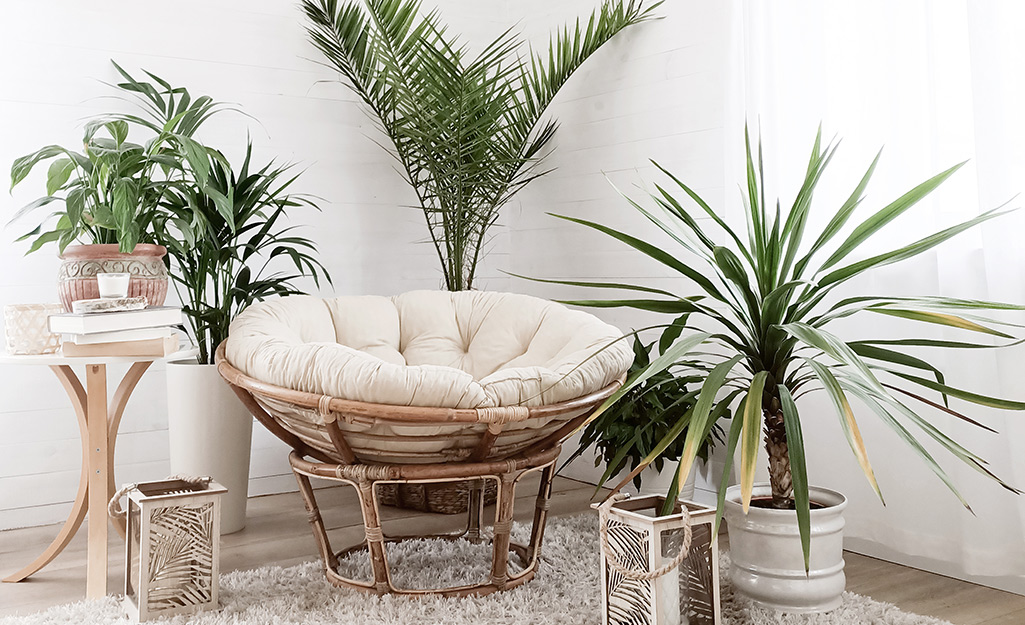
Native to tropical places, many palm plants can grow in your home or yard. Indoors they improve air quality and purify the air of carbon monoxide. Popular indoor potted palms provide a striking look, grow in a container and tolerate in-home environments. Some types of indoor palm plants such as Areca, Majesty and Ponytail really thrive in filtered light and temperatures of 65 to 75 degrees Fahrenheit. Potted palms do well in both foyers and on patios.
Tip: For indoor use, choose shorter, smaller palms and avoid ones that are tall and spindly.
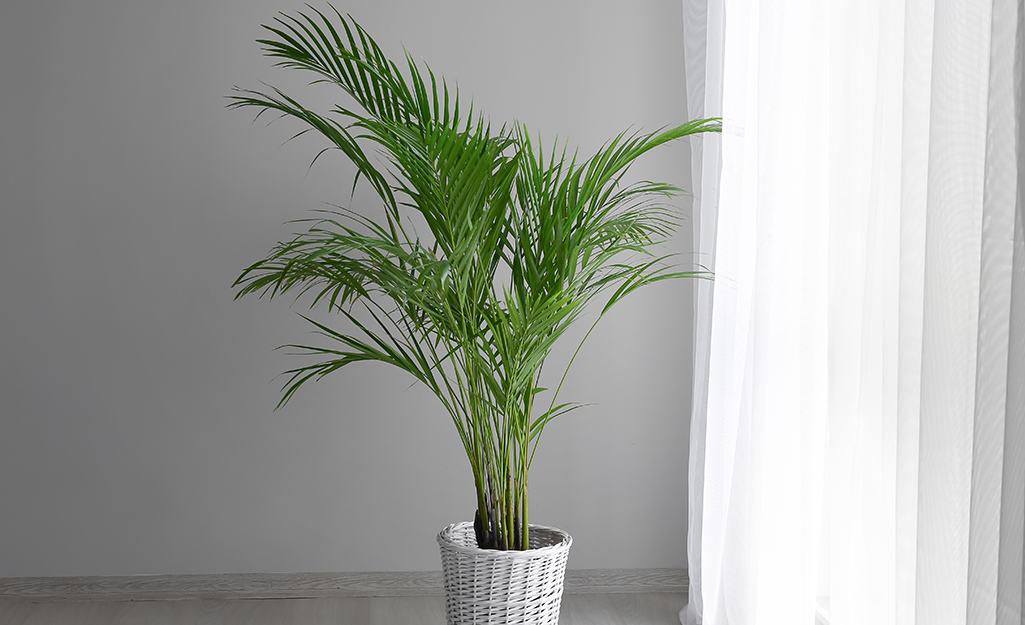
Areca Palms originated in Madagascar and have a smooth green or yellow trunk. Also called Butterfly Palms, they have fronds that curve upward and resemble a butterfly. These types of palm plants grow wider before they get taller. If you want your Areca to stay small, keep it in a smaller container. When in bloom, Areca Palms have yellow flowers and bear small but inedible fruit. They grow best in indirect sunlight. Its leaves can burn so keep it about 5 feet away from direct sun.
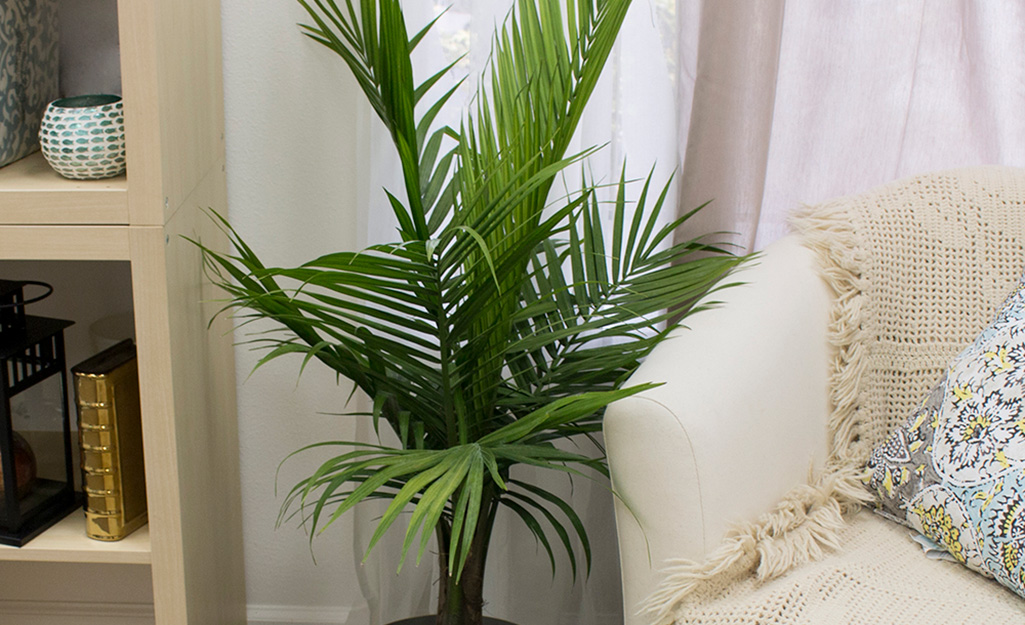
Of all the different kinds of palm plants, Majesty Palms are the ones that bring to mind the tranquility of a walk down the beach. Majesty Palms have a cluster of slender trunks and long stems. Its fronds feature feather-like or pinnate, dark green leaves. When it blooms, it produces white flowers. The flowers eventually turn into bright red but inedible fruit. Majesty Palms grow best in a slightly higher humidity and indirect sunlight.
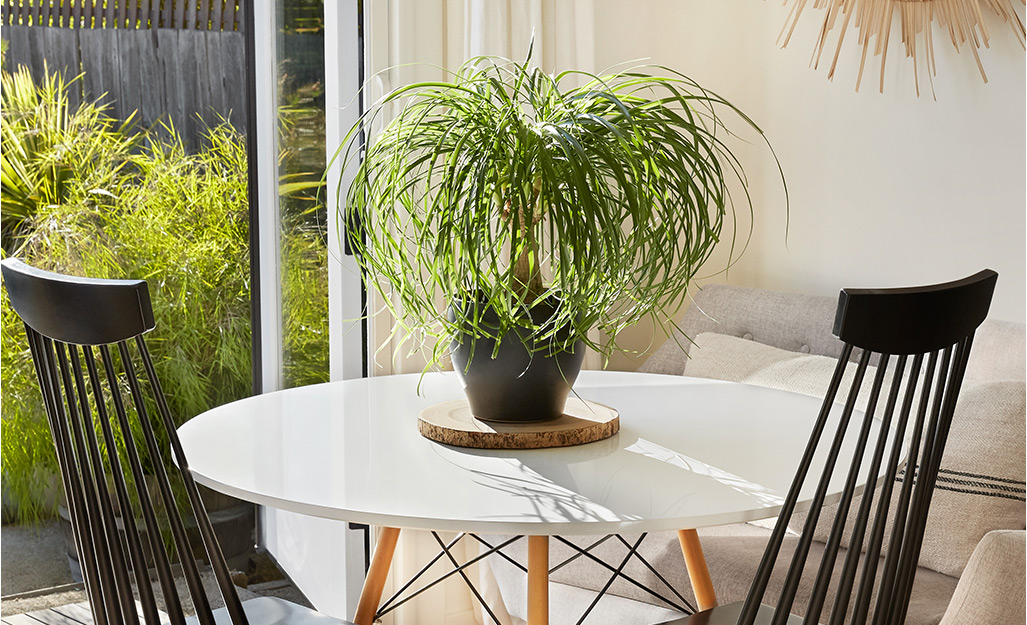
The small but dramatic Ponytail Palm is perfect for tabletops or tucked away in a corner. Native to Mexico, Ponytail Palms are also called Elephant-Foot Tree Palms because of their squat swollen trunk. Ponytail palms have long, thin dark green leaves that grow up and down, resembling a horse’s tail. The Ponytail Palm can bloom white flowers two to three times a year. Make sure it has enough light and allow the soil to dry before you water it.
Robellini or Pygmy Date Palms

A Robellini or Pygmy Date Palm tree is almost the ideal potted houseplant. It has a graceful trunk covered in an attractive texture of old leaves. A Robellini’s bold and bright green leaves extend from its three stems. When in bloom, it has white flowers and yields small red fruit. Unlike other types of indoor palm plants, the fruit is edible. Pygmy Date Palms like full sun and usually require more frequent watering than other potted palms.
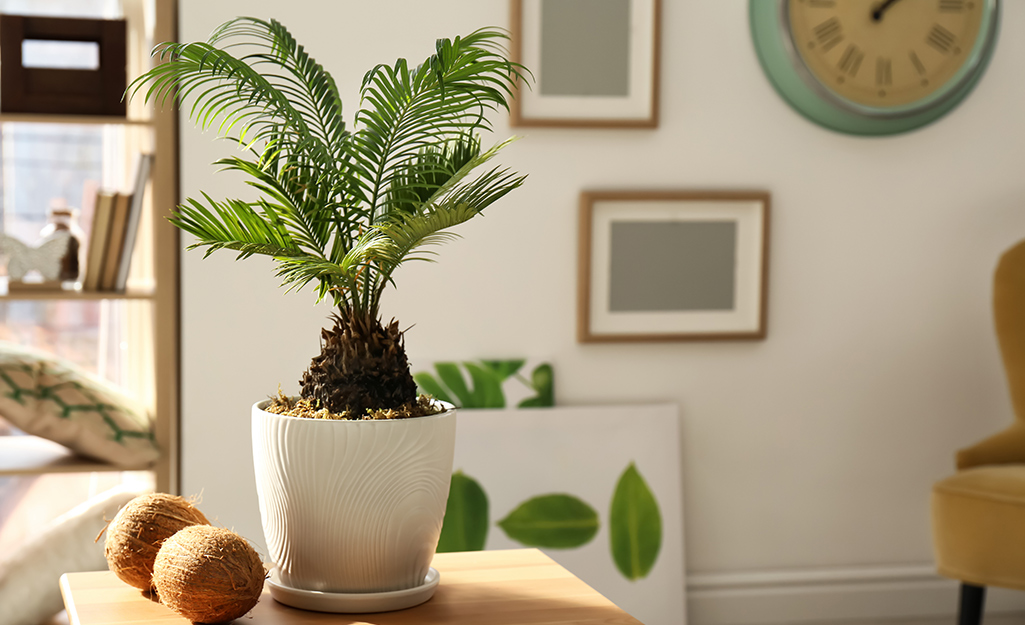
Although they are called palms, Sago Palms are actually cycads. Nonetheless, it has the same tropical look as other types of indoor palm plants. The Sago has a pineapple-shaped, short trunk. Its dark green, glossy leaves end in stiff points and grow in a circular design. Also called the Japanese or King Sago palms, it takes them 13 years to bloom.
Majesty Palm Vs Parlor Palm – Which Palm is Best for You?
FAQ
What are the disadvantages of Areca palms?
They can be susceptible to pests such as spider mites and mealybugs, which require regular monitoring and treatment. Areca Palms also need consistent watering and proper drainage to prevent root rot, making them less suitable for neglectful gardeners.
Which palm is best for indoors?
- Lady Palm (Rhapis excelsa)
- Kentia Palm (Howea forsteriana)
- Fishtail Lawyer palm (Calamus caryotoides)
- Pony Tail Palm (Beaucarnea recurvate)
- Golden Cane (Dypsis lutescens)
- Chinese Fan Palm (Livistona chinensis)
- Walking Stick Palm (linospedix monostachya)
Are majesty palms high maintenance?
A common houseplant, majesty palm grows slowly, becoming larger and more elegant with time and care. Happily, it’s super easy to grow if you give it the right amount of light, water, humidity, and fertilizer.
What is the difference between a palm and Areca Palm?
The primary distinction between parlor palms and areca palms is the shape of their leaves. The parlor palm leaves are delicate and can grow up to 8 inches long. The leaves of an areca palm are larger, reaching several feet. The parlor palm grows upright, whereas the areca palm grows slightly bent.
